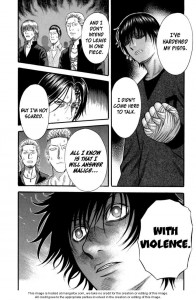Back in June of 2010, a Japanese and American manga publishers formed a coalition for the express purpose of stamping out manga piracy. Shortly thereafter, they struck–One Manga, home to an enormous number of fan scanned and translated manga (scanlations), shut down its operations.
At the time that Alex Leavitt wrote this fantastic analysis of scanlation culture and online manga, One Manga was listed by Google’s ad planner as one of the top 1,000 most trafficked websites in the world. It received just over 4 million in estimated unique monthly visitors, but over 1 billion monthly pageviews. Which makes sense–as each individual page of a manga represented a pageview.
It slapped network ads all over the place, of the pay-per-click sort. Some back of the envelop calculations to give you a sense of the money involved: if all of their ads on a page had a very conservative clickthrough rate of 0.5%, and paid a very conservative $0.05 cost-per-click, that’s 5 million clicks a month which translates to $250 thousand a month in ad revenue. I don’t know how much bandwidth costs for a site serving images a billion times, but it would appear to be tens rather than hundreds of thousands, so it is very likely that the people running One Manga were making an extraordinary profit. This is true even if you go with more conservative estimates than mine, and in my experience, my numbers are pretty conservative.
It makes sense to me that the publishers would target a site like One Manga. What I find interesting is the fact that the big scanlation distributors are basically mirror sites to much smaller communities that do the scanning and translating.
The Network
This is something that the publishers are either completely ignorant of, or just really bad at acting on.
They keep going after the mirror sites, but the network lives on. In the Alex Leavitt post mentioned above, he say:
I predict that, just like the online telenovela audiences, scanlation teams and communities will — in the face of legal action — retreat away from prying eyes into further gated communities, allowing only internal (sometimes P2P-enabled) distribution.
This may happen, but it has not yet. Instead, they strike down One Manga, and occasionally swoop in and make its successors like Manga Fox or Manga Stream take down the big ticket titles like Naruto and Bleach. Which accomplishes nothing, because there are still plenty of places putting scanning and translating super popular titles like that. The very day that they came down, copies of each could be found at manga.animea.net and mangareader.net.
Out of curiosity, after a recent crackdown I googled “Naruto manga”. All ten of the first page search results were mirror sites like the ones mentioned above, not one result pointed to an official, publisher-associated website. And this in spite of the fact that Google has apparently blocked over 600 sites for copyright reasons!
You can kill the mirror sites, but you can’t kill the network. I think that publishers would probably be satisfied if Leavitt’s prediction came true, and scanlation was relegated to small communities exchanging them in private. In an ideal world they don’t want any piracy at all, but without the mirror sites the scale of the audience for such pirated works would be dramatically smaller.
Unfortunately for the publishers, it is trivially easy to set up a website, and the fact that ad networks have automated advertising means that there’s a market for anyone who can marshal a big audience.
Which brings us to the Oatmeal point: the reason that these sites can so easily marshal a big audience is that there is no legitimate alternative.
Not Taking Digital Seriosly
As Leavitt points out:
That problem, though, is two-sided. The obvious first side is that scanlations are technically illegal. But the second — and more important — side is that legal alternatives to online manga distribution do not exist. Yes, you can say that there are experiments with online distribution (such as Viz’s online Signature Ikki magazine), but the fact remains that a universal and ubiquitous legal alternative for online distribution of every English-language manga published in the United States does not currently exist.
iTunes, the Kindle Store, and Netflix have all demonstrated that people will pay for digital content if you give them a chance. The road ahead for manga publishers, if they want to recover the opportunity cost they have incurred from piracy, is to offer Netflix-like bundles for a monthly subscription as well as iTunes-like à la carte services. They could even offer a service for getting new, translated chapters to people within a week of when they come out in Japan, and charge a premium for it. If a bunch of amateur fan translators can get a turnaround time of a few days, surely a professional staff can do it in a week.
The tremendous success of physical manga in the US demonstrates that there is a market. And that existing market could be promoted further if a free digital copy was provided with each sale of a physical volume, something that Marvel recently announced that they would be doing. Author Scott Sigler does this as well for his premium-priced hardcover novel.
In short, fans cannot buy what you are not selling. No amount of piracy-busting is going to change that.

